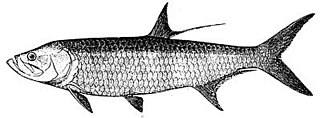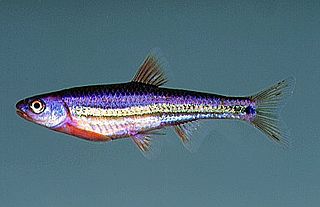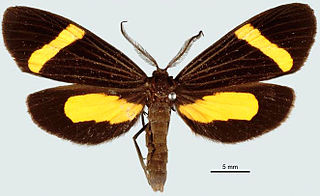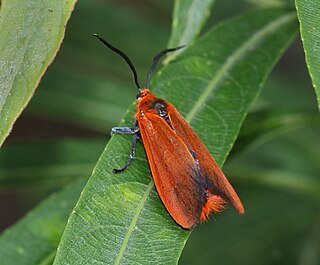The Percopsiformes are a small order of ray-finned fishes, comprising the trout-perch and its allies. It contains just ten extant species, grouped into seven genera and three families. Five of these genera are monotypic.

The Elopiformes are the order of ray-finned fish including the tarpons, tenpounders, and ladyfish, as well as a number of extinct types. They have a long fossil record, easily distinguished from other fishes by the presence of an additional set of bones in the throat.

Papilio is a genus in the swallowtail butterfly family, Papilionidae, as well as the only representative of the tribe Papilionini. The word papilio is Latin for butterfly.

Fundulus is a genus of ray-finned fishes in the superfamily Funduloidea, family Fundulidae. It belongs to the order of toothcarps (Cyprinodontiformes), and therein the large suborder Cyprinodontoidei. Most of its closest living relatives are egg-laying, with the notable exception of the splitfin livebearers (Goodeidae).

Notropis is a genus of freshwater fish in the family Cyprinidae. They are known commonly as eastern shiners. They are native to North America, and are the continent's second largest genus.

Mugil is a genus of mullet in the family Mugilidae found worldwide in tropical and temperate coastal marine waters, but also entering estuaries and rivers.

The Pyralinae are the typical subfamily of snout moths and occur essentially worldwide, in some cases aided by involuntary introduction by humans. They are rather rare in the Americas however, and their diversity in the Australian region is also limited. Altogether, this subfamily includes about 900 described species, but new ones continue to be discovered. Like many of their relatives in the superfamily Pyraloidea, the caterpillar larvae of many Pyralinae – and in some cases even the adults – have evolved the ability to use unusual foods for nutrition; a few of these can become harmful to humans as pests of stored goods.

Teinostoma is a genus of minute sea snails, marine gastropod mollusks or micromollusks in the family Teinostomatidae.
Zygaenosia is a genus of moths in the family Erebidae. The genus was erected by George Hampson in 1900.

Saurorhynchus is an extinct genus of carnivorous bony fish. It is the youngest representative of the family Saurichthyidae and the order Saurichthyiformes. This family is known for its large, elongate jaws, similar to modern Belonidae. Saurichthyidae also includes the Permian genus Eosaurichthys and the Triassic genus Saurichthys.

Hippotion is a genus of sphinx moths. The genus was erected by Jacob Hübner in 1819.

Lyces is a genus of moths of the family Notodontidae erected by Francis Walker in 1854. It consists of the following species:

Erbessa is a genus of moths of the family Notodontidae. It consists of the following species:

Sevenia, commonly called tree nymphs, is a genus of forest butterflies in the family Nymphalidae that, as larvae, feed on plants of the family Euphorbiaceae. There are fourteen species from continental Africa and two species from Madagascar. See Idea for the genus of Southeast Asian tree nymphs.

Saurichthyiformes is an extinct order of ray-finned fish which existed in Asia, Africa, Australia, Europe and North America, during the late Permian to early Middle Jurassic. Saurichthyiiformes comprise two families, Saurichthyidae and Yelangichthyidae. Whereas Yelangichthyidae is monotypic, Saurichthyidae includes at least two genera, Saurorhynchus and the very speciose Saurichthys. Additionally, the subgenera Costasaurichthys, Eosaurichthys, Lepidosaurichthys, and Sinosaurichthys are frequently used to group species. Saurichthyiforms were highly successful predators, and with Yelangichthys possibly even included durophagous forms. Species are known from both marine end freshwater deposits. They had their highest diversity during the Early and Middle Triassic.

Phauda is a genus of moths of the Phaudidae family.
Alophogaster is a genus of moths of the Phaudidae family.

Diplectrum, commonly known as sand perches, is a genus of marine ray-finned fishes which is a member of the subfamily Serraninae of the family Serranidae, which includes the groupers and anthias. There are 12 species distributed in the western Atlantic Ocean and the eastern Pacific Ocean.
Saliunca is a genus of moths belonging to the family Zygaenidae.
Heteropan is a genus of moths belonging to the family Zygaenidae.














